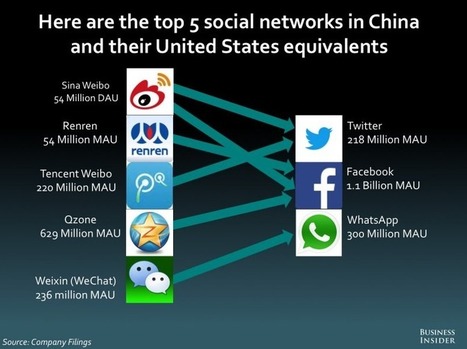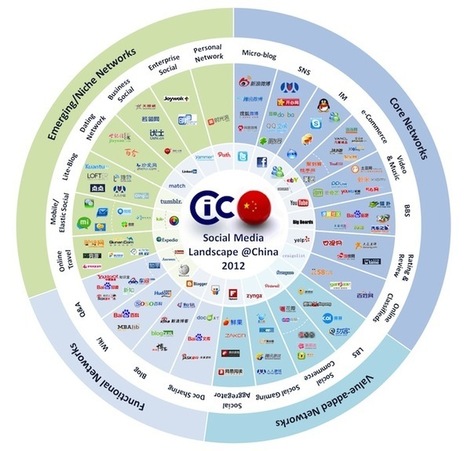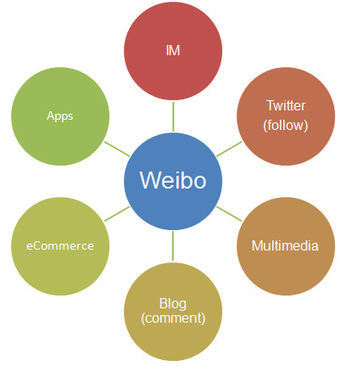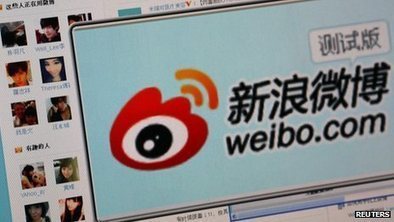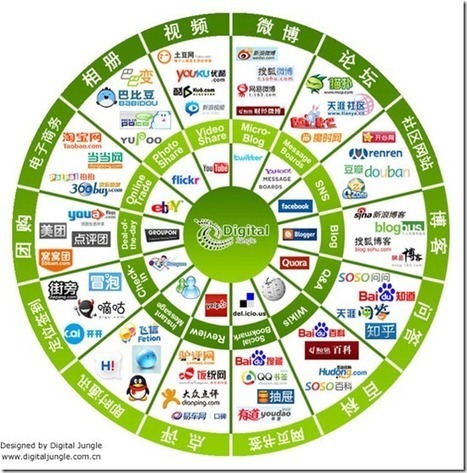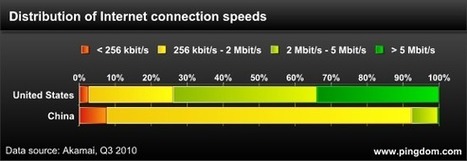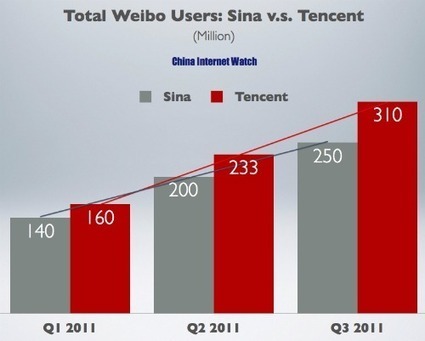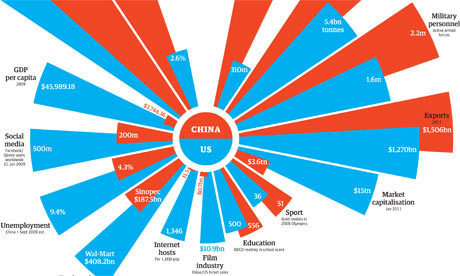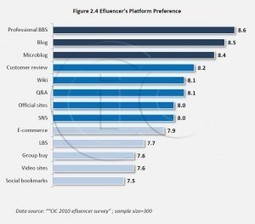 Your new post is loading...
 Your new post is loading...

|
Scooped by
173 Sud
|
Pour comprendre comment les Chinois ont évolué avec le digital, et produisent eux-mêmes aujourd’hui leurs propres innovations, TechNode, la revue qui décrypte les news en Chine, a identifié 6 points-clés pour évoquer cette « Chineseness »
Voir la présentation sur SlideShare

|
Scooped by
173 Sud
|
Many of China's social networks are bigger than the sites most westerners are familiar with.
In fact, four of the world's top 12 social networks are China-based. But it's difficult for non-Chinese to make sense of these sites, and understand what they're used for and how they differ from one another. The helpful graphic below makes sense of China's social media landscape at one quick glance. It is from a new report by BI Intelligence that looks at the main opportunities for tech growth in China.
Sina Weibo resembles both Twitter and Facebook. Users are also limited to 140 characters for their posts, but this allows for more depth than Twitter because 140 characters in Chinese is closer to 70 or 80 words in English — more like Facebook. Also, Sina Weibo has a great deal of flexibility in terms of the type of content people can post, and the service's features.
Tencent Weibo is a microblog that integrates with other Tencent properties, including instant messaging service QQ, and Qzone, a full-service social platform.
WeChat is a messaging-focused app. Renren is very similar to Facebook.
Read more: http://goo.gl/D4KZx5

|
Scooped by
173 Sud
|
A l’heure où Facebook, Google ou Twitter s’imposent comme les acteurs hégémoniques des tendances du tout-connecté, vecteurs de l’élan d’un Internet résolument démocratique, libertaire dans l’accès et dans l’expression, la Chine – et les pratiques digitales qui s’y rapportent – apparaissent encore comme entités en marge du progrès. Paradoxalement, les marchés asiatiques suscitent un réel engouement auprès des annonceurs ; de fait – et bien au-delà des faux-semblants de l’archaïsme ou du contrôle – la Chine s’impose dès aujourd’hui comme véritable modèle dans les pratiques e-marketing, illustrant en amont les best practices de nos 10 prochaines années. Une enquête du Boston Consulting Group porte à plus de 540 millions le nombre d’internautes asiatiques – dont 75% d’entre eux sont également pourvus en dispositifs de consultation mobiles, tels que smartphones ou tablettes, conçus comme points d’accès réseaux redondants. En parallèle de ce taux d’équipement Internet, on constate plus de 1,2 milliards d’habitants pourvus en téléphones mobiles ; la hauteur du taux de pénétration conditionne un rapport différent de ceux auxquels nous sommes coutumiers, de l’homme au produit qu’on lui vante. L’écart de possession se double d’une divergence en terme d’usages : les Européeens utilisent 25% des capacités de leur smartphone, contre 85% en Chine. L’ensemble des pratiques et conceptions du web chinois s’appréhende à l’aune d’un paradigme similaire, élaboré via synthèse de ces deux éléments : l’abondance de la participation institue un rapport vertueux d’influence. Cette mise en cohésion de la marque et des médias sociaux émerge essentiellement de l’audience en terme de qualification : si le coeur des réseaux occidentaux s’agrège autour des 18-25 ans – excluant partiellement ceux qui disposent du pouvoir d’achat le plus important, par effet de déphasage technologique – on constate que le marché chinois associe de manière indubitable consommateurs et e-prescripteurs (qu’ils s’agissent de conseillers pro-actifs ou de relais de transaction). 96% des adultes en Chine sont actifs d’une manière ou d’une autre sur les médias sociaux et 85% se considèrent comme véritables créateurs de contenus de marque (contre 1% en France, selon les estimations). Lire cet excellent article : http://goo.gl/IDrsyW

|
Scooped by
173 Sud
|
La Chine, souvent décrite comme un territoire hostile à Facebook et Twitter, a su faire de sa population une vraie population digitale. Quelques chiffres à retenir : La Chine compte plus de 560 millions d’internautes soit 42% de la population ; 75% des internautes Chinois sont des mobinautes et à l’instar de d’autres pays Asiatiques ou Africains, le développement de l’usage d’Internet a été conjugué à celui de l’explosion du marché des smartphones ; Tencent est la 3ème plus grosse société Internet au niveau mondial après Google et Amazon ; 91% des internautes Chinois sont inscrits sur au moins un réseau social (contre moins de 80% en France) ; Les médias sociaux phares sont d’abord des me-too de services occidentaux (on a déjà connu ça dans le domaine industriel) : Baidu (Google), RenRen (Facebook), Sina Weibo (Twitter), YouKu (Youtube) ; Le Social Commerce et notamment le partage d’avis sur les produits est un enjeu e-commerce prioritaire puisque 40 % des acheteurs online consultent et postent des avis sur les produits (selon le cabinet BCG) et 38% utiliseraient les réseaux sociaux dans leur parcours d’achat. Même si la Chine est digitale, elle a des usages bien différents au niveau des outils utilisés, compte tenu de ces restrictions qui ont permis le succès de pure players locaux. Qu’ils s’appellent Klaixin, Douban ou bien encore Jiepang, ces sites font fureur en Chine et ont clairement des ambitions d’internationalisation à l’instar du géant Chinois de l’Internet Tencent (Tencent, ce géant de l’Internet Chinois que vous ne connaissez peut-être pas encore). Lire l'article : http://goo.gl/dBiF1A

|
Scooped by
173 Sud
|
In times when social media influence is flourishing, new technologies and ideas can be embraced and adopted with astonishing speed, instigating significant and often unpredictable consequences. Recent evidence of this is the unexpectant rise of microblogging activity. Since launching the first microblog site in 2007, Fanfou with 0.3 million users, the number of microblog users has grow to 250 million by the end of 2011 with the majority of Chinese netizens have at least 2 profiles in different microblogging platforms. The following infographic was developed to give you the overall picture of how extensive microblogging platforms are so brands can be aware of ‘How to float their boat in the Chinese Ocean of Social media’ to reach a certain destination and turn microblogging influence into an effective marketing tool. Chinese Internet users are active and goal directed. These traits make the Chinese netizen highly desirable for Brands who want to connect and build two-way communications with their consumers, since it gives an ability to communicate directly with the target group, which was unimaginable just a few years ago. Research shows that since August 2011, microblogging ranked as the primary and most reliable source of news and information. This extensive digital iceberg is drowning the once thought to be unsinkable traditional media ship (radio, newspapers, TV). A specific emphasis should be made to the microblogging platform Sina Weibo (literally Sina “Micro-blog”). It is the new undisputable leader among Chinese social channels and an interesting platform from a marketing perspective, being used in order to reach large numbers of Chinese netizens. Sina Weibo has become a force to be reckoned within only 2 years of existence and has taken off among celebrities, executives, politicians and, obviously, advertisers. Fast facts about Sina Weibo: 250+ registered users; 50,000 corporate accounts; 60,000 – government-related accounts; 86 million posts per day 87% - market share by browsing time 56% - microblog market share 181% - increase in users over the last year Sina Weibo – top 10th biggest global network Together with Sina’s main rival, Tencent Weibo's 200 million+ registered users, that's an impressive 450 million+ registered microblogging accounts. Another amazing trend to consider is the popularity of accessioning Internet through mobile devices which has now over taken those using a PC to connect.

|
Scooped by
173 Sud
|
Sina Weibo is not a copycat of Twitter. It works more like Google Plus. When it comes to talking about Sina Weibo, many of my foreign friends tend to explain it as “a copycat of Twitter”. This kind of makes sense, since both of them are microblogging platforms, where you can only post short messages of up to 140 words. However, a simple definition like “Twitter’s copycat” doesn’t really tell what Sina Weibo is, because when you really put your hands on it, you can find so many differences between them. So what is Sina Weibo anyway? Sina Weibo = Twitter + Blog + IM + Multimedia + Twittering First, Weibo is a microblogging platform that works like Twitter. You can post updates within 140 words, insert links in your updates, and follow people you are interested in. This is exactly the way you play with Twitter. + Blogging Weibo is partly a blogging service too because you can comment on someone’s updates and directly engage in the conversation, as shown below. + IM You can also directly chat with your friends on Weibo. Here is anther post Ryan wrote about Weibo IM earlier. + Multimedia Only inserting links in updates is not enough. On Weibo, you can add audio, video and images, and your followers can directly check them within your update.

|
Scooped by
173 Sud
|
Selon China Internet Network Information Center (contrôlé par l’État), l'utilisation d'Internet en Chine est passé en dix ans (2000 à 2010) de moins de 1 pour cent de la population à plus de 28 pour cent. À la fin de 2011, plus de 500 millions de citoyens chinois sont en ligne à et un quart de tous les utilisateurs des réseaux sociaux dans le monde sont chinois. Il s’agit d’un des changements technologiques les plus marquants dans l'histoire récente de l’humanité. Selon une étude récente de Forester, les médias sociaux sont bien plus qu’un phénomène social. C'est un mode de vie pour une grande partie de la population chinoise. Plus de 97% des internautes dans les grandes villes chinoises utilisent chaque jour les médias sociaux pour s’engager dans des conversations et construire des relations. Le paysage numériques en Chine évolue sur une base presque quotidienne. Il s’agit d’une histoire passionnante à découvrir et à suivre. Ces présentations de Burson-Marsteller et We Are Social Singapore résument la situation en Chine en 2011. Suivez ce lien pour lire la suite : http://goo.gl/LGuOT

|
Scooped by
173 Sud
|
China’s internet speed and broadband charges have long been drawing Chinese netizens’ concerns. Recently, one of China’s telecom experts claimed that China’s internet speed is above average with low charges. Such a claim was questioned by most netizens. According to some analysis report which had issued last year, with income gap adjusted, China’s broadband has charged 124 times more then South Korea, but provides unsatisfactory network speeds. China has been putting huge investment into almost every aspect of its economy, yet one crucial area in which China has been lagging behind is the internet network.

|
Scooped by
173 Sud
|
A recent social media study conducted by Forrester Research, with over 330,000 completed surveys from around the world, has reinforced figures on social media use in the US and Europe, while also giving readers an interesting insight into how users are approaching these tools in new and emerging markets. The first piece of obvious information you can come away with from the report is that the overwhelming majority of social media users are classified as ‘spectators,’ in both the US and in the 7 European countries surveyed – UK, France, Germany, Italy, the Netherlands, Spain, and Sweden. In the US, the spectator category makes up 73% of users, while in Europe it drops only slightly to 69%. Creators account for only one quarter of their social media users, while ‘conversationalists’ are ahead of them only slightly, accounting for 36% of US users, and 26% of Europe’s users.

|
Scooped by
173 Sud
|
Looking back at China’s internet in 2011, there were three broad trends that deserve greater attention. + The first trend was a general shift from emotionally-driven nationalist chatter as the defining tone of China’s internet toward a more basic attention to issues of public welfare. + The second was the rise of what we can call the “social power of the internet” (网络社会力). + And the third trend was a more pronounced deficit in understanding on the government’s part about the role it should play in a networked society. While it became readily apparent, that is, that we now have a networked civil society in China, it became clearer at the same time that we lack government administrators who are internet literate (网络化的治理者) …. Clearly, the winds are changing. When you cannot find safe milk for your child to drink, when their school buses are hazardous, when you worry that you might be exposed to dangerous recycled cooking oils if you go out to a local restaurant, when the city where you live is choked with pollution and you have no idea what the actual PM2.5 measures for the most dangerous air particles are, the question that possesses you above all else is what direction Chinese society is heading. You care more about how the people of China can enjoy lives of peace and prosperity, and less about the murderous logic of the Boxer Rebellion. Underlying these trends was the continued rise of the microblog. The number of weibo users reportedly quadrupled last year to a quarter of a billion, almost half of China’s online population, from 63 million at the end of 2010. But this growth tailed off in the second half of the year, according to a report from the China Internet Network Information Center.

|
Scooped by
173 Sud
|
The heads of 39 IT companies will assist the Chinese government in monitoring and censoring online content, a decision that was reached after a three-day training session held by the State Internet Information Office. State-run news agency Xinhua reported that a "consensus" has been reached by leaders in the internet, telecom and computer industries to tighten control over web content. Over the past decade, the government has run a massive internet censorship campaign. But as internet usage has increased, the dissemination of information has become more difficult to keep under control. China now has 500 million internet users, more than the population of the European Union or the United States. An important strategy of the government has been to persuade — or require — private companies to do its bidding. China's home-grown social media sites have been left relatively uncensored so far. While Facebook and Twitter are blocked, Sina Weibo and Tencent are not. The lack of restriction has not gone unnoticed by China's netizens. Active discussion on previously taboo topics has flourished on the indigenous sites, and millions of netizens use them daily to vent their anger — at times directed at the government. News of corruption, protests, or scandal can spread within minutes on sites like Sina Weibo.

|
Scooped by
173 Sud
|
Qihoo 360 (NYSE:QIHU), the Chinese anti-virus vendor, has made yet another move into social media with its launch today of a Pinterest clone called ‘I Like.’ Just like the original, the site is for sharing and ‘liking’ random images that people post, which tend to be ones related to fashion, gadgets, and showing off what individuals own. It’s the second such Pinterest-like site from a major Chinese web company just this month, following hot on the heels of Renren’s (NYSE:RENN) new Plaza. But whereas Plaza users seem obsessed with linking to items that they’re selling on the Taobao e-commerce site, the peeps on ‘I Like’ seem to be more laid-back and with no set agenda.

|
Scooped by
173 Sud
|
China’s authorities try to curtail the internet and especially try to implement a ‘real-name’ policy for online debate. But internet watcher Jeremy Goldkorn does not see the end of the internet in China as we know it, he tells in the Voice of America. Jeremy Goldkorn, the founder of the China media monitoring website Danwei.org says although authorities said the new system would start in December, not much has changed. “I don’t think it has actually been implemented anywhere, at least not thoroughly. Because it’s still possible to do a lot in the Internet without using your real name, including Weibo services.” If authorities do follow through on the plan, Goldkorn agrees with other critics who say that the loss of anonymity will have a big impact on microblogs. “It will certainly have a chilling effect on discussion on Weibo, because a lot of people will be wary of speaking their mind if there is going to be a real name attached to their account. But I don’t think it’s going to kill off Weibo,” Goldhorn said.
|

|
Scooped by
173 Sud
|
Here are 14 charts selected from iResearch annual report of China internet. Our selection may help you understand the development and status of China internet better.

|
Rescooped by
173 Sud
from Geeks
|
Pour moi (@franckperrier) la bataille du e-commerce mondial n’a pas commencé. En effet, tant que les trois monstres dominateurs du e-commerce mondial que sont Amazon Alibaba et Rakuten ne se seront pas réellement affrontés nous n’aurons rien vu. Et les industriels peuvent être soucieux devant des décisions qui vont devenir difficiles à prendre. 2014, nous rentrons dans la deuxième phase du commerce en ligne, qui après 15 années de balbutiements, à enfin trouvé son modèle. L'ambition est donnée, les investisseurs suivent, et l’on commencent à se douter que la ‘’non rentabilité’’, argument des inquiets de la montée en puissance des cybers commerçants, est une stratégie en soi : oui ils ne gagnent pas d'argent, mais pour les leaders du e-commerce tout réinvestir pour aller le plus vite possible et prendre des positions à tout prix est une stratégie, et le vrai combat arrive maintenant. Depuis quelques semaines, Alibaba annonce ouvertement son intention de détrôner Wallmart de son leadership mondial du commerce BtoC dès 2016. Et en allant l’attaquer sur ses propres terres, notamment en rachetant 206 M$ Shop Runner, le leader de la logistique et de la livraison ‘’one day delivery’’ aux états unis. Contrer doublement Amazon, Wallmart, et accessoirement Google shopping et eBay. Ce n'est qu'une question de temps Alibaba inéluctablement devrait devenir leader mondial du commerce - oui je dis bien du commerce mondial pas seulement du e-commerce : un leadership qui devrait donc basculer du Offline Walmart CA 469 Md$ / 2012 (Carrefour N°2 mondial ) et stagen voire régresse, au prpofit du Online Alibaba et ses filiales qui annonce une estimation de 490 Md$ en 2016. (Amazon 69 Md$ / 2012) Et quand vous pensez qu’Amazon met comme priorité d’exister sur le marché chinois alors qu’il n’y pèse que 3% du marché (ex joyo) face à TMall qui en détient 51,3% / Q1 2013… et qu’Amazon ne peut pas se passer d’aller en Chine, qui représentera d’ici 2016 27% des achats de détails mondial. Il y a encore des batailles à livrer. Même si l'arme Kindle sera un atout. Au-delà de la prise de leadership mondial par le e-commerce qui n’existait pas il y a 15 ans… mon inquiétude vient aussi de l’évolution des formats qui gagnent :c’est inéluctable un nouveau modèle de commerce va dominer le monde : les places de marché. Lire l'article de @franckperrier : http://goo.gl/BdH5Qs
Via Bruno Sanlaville , 694028
More than two million people in China are employed by the government to monitor web activity, state media say, providing a rare glimpse into how the state tries to control the internet. The Beijing News says the monitors, described as internet opinion analysts, are on state and commercial payrolls. China's hundreds of millions of web users increasingly use microblogs to criticise the state or vent anger. Recent research suggested Chinese censors actively target social media. The report by the Beijing News said that these monitors were not required to delete postings. They are "strictly to gather and analyse public opinions on microblog sites and compile reports for decision-makers", it said. It also added details about how some of these monitors work. Continue reading the main story : http://goo.gl/EJTBDA Analysis China's internet is one of the most controlled and censored in the world. Websites deemed to be subversive are blocked. Politically sensitive postings are routinely deleted . Even the name of the former Prime Minister Wen Jiabao was censored when rumours were circulating on the internet that his family had amassed a fortune while he was in power. But with the rapid growth of internet users, the ruling Communist Party has found itself fighting an uphill battle. The Beijing News, while reporting the story of microblog monitors, has admitted that it is impossible for the government to delete all "undesirable" postings. The more postings deleted, the more they appear, it says. China seldom reveals details about how it monitors and controls the internet. The government even does not acknowledge that it blocks web sites. But the report does offer a rare glimpse into this opaque world.
Via Gust MEES

|
Scooped by
173 Sud
|
Sina Weibo, China’s cult Twitter alternative, broke its record for the average number of tweets per second during Chinese New Year last night, beating even Twitter’s own best. According to a report from Do News [Chinese], the microblogging service saw an average of 32,312 messages sent per second, as an astonishing 481,207 messages were sent during the first minute of the new year. What’s particularly impressive is that the figure is greater than the highest volume of messages ever recorded on Twitter – 25,088 per second — which was hit when Japanese users took to the service during a national broadcast of popular Anime series Castle in the Sky in December. A recent report from the China Internet Network Information Center (CNNIC) found that the usage of Weibo services increased by 296 percent in 2011, with almost half (48.7 percent) of Chinese Internet users now signed up to use microblogs.

|
Scooped by
173 Sud
|
Les Chinois sont obsédés par l'Internet. En 2009, les gens dans les 60 plus grandes villes de la Chine consacraient environ 70 % de leur temps libre sur l'Internet (50 % dans les petites villes) [Cabinet McKinsey]. En 2011, plus de 97 % de ces internautes utilisent chaque jour les médias sociaux pour engager des conversations et construire des relations [Forester]. Plus étonnant, les internautes chinois ont accès à une grande variété de plates-formes développées pour le marché intérieur, se comparant avantageusement aux services étrangers. Sam Flemming, un spécialiste des réseaux sociaux en Chine, suggère que ce pays dispose du paysage numérique le plus complexe, le plus fragmenté, mais aussi le plus développé du monde. Suivez ce lien pour lire la suite : http://goo.gl/0FOQg

|
Scooped by
173 Sud
|
Smartphone shipments to China rose to a record 24m during the period, compared with 23m for the US, according to research done by Strategy Analytics. The consultancy said shipments to China were boosted by "a wave of low-cost Android models from local Chinese brands". This is the first time that China has overtaken the US in smartphone market. "China's rapid growth has been driven by an increasing availability of smartphones in the retail channels," said Tom Kang, of Strategy Analytics. The company said that while shipments to China grew by 58% sequentially during the period, those to the US fell by 7%.

|
Scooped by
173 Sud
|
Arguably, there are currently only two superpowers on the planet: the United States and China. Now that the world is growing increasingly dependent on the Internet, how do these two giants stack up online? We’ve taken a number of Internet-related metrics to compare the two countries, things like the number of Internet users, Internet penetration, the speed of Internet connections, the number of domain names, favorite websites, web browsers, operating systems and more.

|
Scooped by
173 Sud
|
We created a chart for a quick comparison of Sina and Tencent's Weibo platforms in China in the last three quarters. Tencent Weibo is growing faster than Sina Weibo; the number of daily active users on Tencent Weibo has exceeded 50 million, which is twice of Sina Weibo.

|
Scooped by
173 Sud
|
How do China and America compare on the internet? When Hu Jintao visited the White House earlier this year, we picked some key facts about China and the USA to compare the two superpowers. Since then the people over at Pingdom have put together their own fact comparison of China and the US, this time with an emphasis on internet usage and the online industry. Like us, they picked some of their figures from the CIA World factbook, but they also drew from the Internet World Stats website.
We have collected all the statistics from the Pingdom report into a spreadsheet on in the data section below.

|
Scooped by
173 Sud
|
Though the number of PC netizens is 107m larger than that of mobile netizens in 2010, based on DCCI’s research data, the latter will be 16m larger than the former. With the rapid adoption of mobile & smart phone, more and more people prefer this convenient internet access. Mobile internet has already become the new battle field of current online marketing, and the battle is likely to be more fiercer in the coming future.

|
Scooped by
173 Sud
|
The suggestions from netizens on platforms such as professinal bbs, blogs and microblogs are reported as reliable as that of their friends or family members. As to the voices on those platforms with score range from 8 to 8.2, they can also be accepted by the netizens. Highly like to be driven by commercial interests, those platforms with socre range form 7.5-7.9 is less trusted by the netizens.

|
Scooped by
173 Sud
|
Government restrictions are driving young Chinese to turn off their TV sets and turn on their computers. Advertisers and Western studios are right there with them. China's streaming-video sites once were derided by the global entertainment industry as homes of stolen movies and television shows. But many sites have cracked down on piracy and are offering original programming, as well as licensed Western movies and TV shows such as "Gossip Girl" and "Mad Men." As a result, ad revenue for Chinese video websites operated by Youku Inc., Tudou Holdings Ltd., Baidu Inc., Sohu.com Ltd. and others surged to 1.48 billion yuan ($235 million) in the third quarter, up 48% from the second quarter, according to market-data firm Analysys International. Some sites are starting to offer some premium content, charging Chinese consumers for each viewing or on a monthly basis. "People are getting used to paying for content," said Gary Wang, chief executive of Tudou, which has about 12 million paying mobile subscribers.
|



 Your new post is loading...
Your new post is loading...



